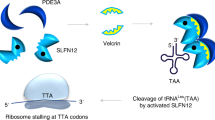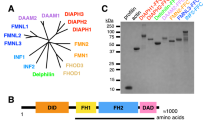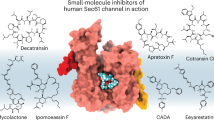Abstract
Inspired by the usefulness of small molecules to study membrane traffic, we used high-throughput synthesis and phenotypic screening to discover secramine, a molecule that inhibits membrane traffic out of the Golgi apparatus by an unknown mechanism. We report here that secramine inhibits activation of the Rho GTPase Cdc42, a protein involved in membrane traffic, by a mechanism dependent upon the guanine dissociation inhibitor RhoGDI. RhoGDI binds Cdc42 and antagonizes its membrane association, nucleotide exchange and effector binding. In vitro, secramine inhibits Cdc42 binding to membranes, GTP and effectors in a RhoGDI-dependent manner. In cells, secramine mimics the effects of dominant-negative Cdc42 expression on protein export from the Golgi and on Golgi polarization in migrating cells. RhoGDI-dependent Cdc42 inhibition by secramine illustrates a new way to inhibit Rho GTPases with small molecules and provides a new means to study Cdc42, RhoGDI and the cellular processes they mediate.

This is a preview of subscription content, access via your institution
Access options
Subscribe to this journal
Receive 12 print issues and online access
$259.00 per year
only $21.58 per issue
Buy this article
- Purchase on Springer Link
- Instant access to full article PDF
Prices may be subject to local taxes which are calculated during checkout






Similar content being viewed by others
Change history
07 March 2006
note made in HTML and Fig 3a; PDF appended; corrected online date added to PDF
Notes
*Note: In the version of this article initially published online, two labels in Figure 3a are incorrect. The label in the square below the arrow for step 2 should read 'Cdc42 GTP' instead of 'Cdc42 GDP', and ‘PI’ in step 4 should be ‘Pi’. These errors have been corrected in the PDF version of the article.
References
Klausner, R.D., Donaldson, J.G. & Lippincott-Schwartz, J. Brefeldin A: insights into the control of membrane traffic and organelle structure. J. Cell Biol. 116, 1071–1080 (1992).
Feng, Y. et al. Exo1: A new chemical inhibitor of the exocytic pathway. Proc. Natl. Acad. Sci. USA 100, 6469–6474 (2003).
Feng, Y. et al. Retrograde transport of cholera toxin from the plasma membrane to the endoplasmic reticulum requires the trans-Golgi network but not the Golgi apparatus in Exo2-treated cells. EMBO Rep. 5, 596–601 (2004).
Wang, B., Wylie, F.G., Teasdale, R.D. & Stow, J.L. Polarized trafficking of E-cadherin is regulated by Rac1 and Cdc42 in Madin-Darby canine kidney cells. Am. J. Physiol. Cell Physiol. 288, C1411–C1419 (2005).
Kroschewski, R., Hall, A. & Mellman, I. Cdc42 controls secretory and endocytic transport to the basolateral plasma membrane of MDCK cells. Nat. Cell Biol. 1, 8–13 (1999).
Camera, P. et al. Citron-N is a neuronal Rho-associated protein involved in Golgi organization through actin cytoskeleton regulation. Nat. Cell Biol. 5, 1071–1078 (2003).
Bishop, A.L. & Hall, A. Rho GTPases and their effector proteins. Biochem. J. 348, 241–255 (2000).
Stamnes, M. Regulating the actin cytoskeleton during vesicular transport. Curr. Opin. Cell Biol. 14, 428–433 (2002).
Pelish, H.E., Westwood, N.J., Feng, Y., Kirchhausen, T. & Shair, M.D. Use of biomimetic diversity-oriented synthesis to discover galanthamine-like molecules with biological properties beyond those of the natural product. J. Am. Chem. Soc. 123, 6740–6741 (2001).
Presley, J.F. et al. ER-to-Golgi transport visualized in living cells. Nature 389, 81–85 (1997).
Hirschberg, K. et al. Kinetic analysis of secretory protein traffic and characterization of Golgi to plasma membrane transport intermediates in living cells. J. Cell Biol. 143, 1485–1503 (1998).
Ma, L., Cantley, L.C., Janmey, P.A. & Kirschner, M.W. Corequirement of specific phosphoinositides and small GTP-binding protein Cdc42 in inducing actin assembly in Xenopus egg extracts. J. Cell Biol. 140, 1125–1136 (1998).
Ho, H.Y. et al. Toca-1 mediates Cdc42-dependent actin nucleation by activating the N-WASP-WIP complex. Cell 118, 203–216 (2004).
Rohatgi, R. et al. The interaction between N-WASP and the Arp2/3 complex links Cdc42-dependent signals to actin assembly. Cell 97, 221–231 (1999).
Cooper, J.A., Walker, S.B. & Pollard, T.D. Pyrene actin: documentation of the validity of a sensitive assay for actin polymerization. J. Muscle Res. Cell Motil. 4, 253–262 (1983).
Olofsson, B. Rho guanine dissociation inhibitors: pivotal molecules in cellular signaling. Cell. Signal. 11, 545–554 (1999).
Benard, V., Bohl, B.P. & Bokoch, G.M. Characterization of Rac and Cdc42 activation in chemoattractant-stimulated human neutrophils using a novel assay for active GTPases. J. Biol. Chem. 274, 13198–13204 (1999).
Papayannopoulos, V. et al. A polybasic motif allows N-WASP to act as a sensor of PIP2 density. Mol. Cell 17, 181–191 (2005).
Zhang, B., Zhang, Y., Wang, Z. & Zheng, Y. The role of Mg2+ cofactor in the guanine nucleotide exchange and GTP hydrolysis reactions of Rho family GTP-binding proteins. J. Biol. Chem. 275, 25299–25307 (2000).
Schacht, J. Purification of polyphosphoinositides by chromatography on immobilized neomycin. J. Lipid Res. 19, 1063–1067 (1978).
Lin, H.C., Barylko, B., Achiriloaie, M. & Albanesi, J.P. Phosphatidylinositol (4,5)-bisphosphate-dependent activation of dynamins I and II lacking the proline/arginine-rich domains. J. Biol. Chem. 272, 25999–26004 (1997).
Jost, M., Simpson, F., Kavran, J.M., Lemmon, M.A. & Schmid, S.L. Phosphatidylinositol-4,5-bisphosphate is required for endocytic coated vesicle formation. Curr. Biol. 8, 1399–1402 (1998).
Erickson, J.W., Zhang, C., Kahn, R.A., Evans, T. & Cerione, R.A. Mammalian Cdc42 is a brefeldin A-sensitive component of the Golgi apparatus. J. Biol. Chem. 271, 26850–26854 (1996).
Fucini, R.V., Chen, J., Sharma, C., Kessels, M.M. & Stamnes, M. Golgi vesicle proteins are linked to the assembly of an actin complex defined by mAbp1. Mol. Biol. Cell 13, 621–631 (2002).
Wu, W.J., Erickson, J.W., Lin, R. & Cerione, R.A. The gamma-subunit of the coatomer complex binds to Cdc42 to mediate transformation. Nature 405, 800–804 (2000).
Chen, J. et al. Coatomer-bound Cdc42 regulates dynein recruitment to COPI vesicles. J. Cell Biol. 169, 383–389 (2005).
Musch, A., Cohen, D., Kreitzer, G. & Rodriguez-Boulan, E. Cdc42 regulates the exit of apical and basolateral proteins from the trans-Golgi network. EMBO J. 20, 2171–2179 (2001).
Etienne-Manneville, S. & Hall, A. Integrin-mediated activation of Cdc42 controls cell polarity in migrating astrocytes through PKCzeta. Cell 106, 489–498 (2001).
Gomes, E.R., Jani, S. & Gundersen, G.G. Nuclear movement regulated by Cdc42, MRCK, myosin, and actin flow establishes MTOC polarization in migrating cells. Cell 121, 451–463 (2005).
Hoffman, G.R., Nassar, N. & Cerione, R.A. Structure of the Rho family GTP-binding protein Cdc42 in complex with the multifunctional regulator RhoGDI. Cell 100, 345–356 (2000).
Peyroche, A. et al. Brefeldin A acts to stabilize an abortive ARF-GDP-Sec7 domain protein complex: involvement of specific residues of the Sec7 domain. Mol. Cell 3, 275–285 (1999).
Mansour, S.J. et al. p200 Arf-GEP1: a Golgi-localized guanine nucleotide exchange protein whose Sec7 domain is targeted by the drug brefeldin A. Proc. Natl. Acad. Sci. USA 96, 7968–7973 (1999).
Keep, N.H. et al. A modulator of rho family G proteins, rhoGDI, binds these G proteins via an immunoglobulin-like domain and a flexible N-terminal arm. Structure 5, 623–633 (1997).
Nobes, C.D. & Hall, A. Rho, Rac, and Cdc42 GTPases regulate the assembly of multimolecular focal complexes associated with actin stress fibers, lamellipodia, and filopodia. Cell 81, 53–62 (1995).
DerMardirossian, C., Schnelzer, A. & Bokoch, G.M. Phosphorylation of RhoGDI by Pak1 mediates dissociation of Rac GTPase. Mol. Cell 15, 117–127 (2004).
Luna, A. et al. Regulation of protein transport from the Golgi complex to the endoplasmic reticulum by Cdc42 and N-WASP. Mol. Biol. Cell 13, 866–879 (2002).
Vasudevan, A. et al. Potent, highly selective, and non-thiol inhibitors of protein geranylgeranyltransferase-I. J. Med. Chem. 42, 1333–1340 (1999).
Gao, Y., Dickerson, J.B., Guo, F., Zheng, J. & Zheng, Y. Rational design and characterization of a Rac GTPase-specific small molecule inhibitor. Proc. Natl. Acad. Sci. USA 101, 7618–7623 (2004).
Cole, N.B., Ellenberg, J., Song, J., DiEuliis, D. & Lippincott-Schwartz, J. Retrograde transport of Golgi-localized proteins to the ER. J. Cell Biol. 140, 1–15 (1998).
Rossman, K.L. et al. A crystallographic view of interactions between Dbs and Cdc42: PH domain-assisted guanine nucleotide exchange. EMBO J. 21, 1315–1326 (2002).
Peterson, J.R., Lokey, R.S., Mitchison, T.J. & Kirschner, M.W. A chemical inhibitor of N-WASP reveals a new mechanism of targeting protein interactions. Proc. Natl. Acad. Sci. USA 98, 10624–10629 (2001).
Gallusser, A. & Kirchhausen, T. The beta 1 and beta 2 subunits of the AP complexes are the clathrin coat assembly components. EMBO J. 12, 5237–5244 (1993).
Acknowledgements
We thank S.C. Harrison for comments on the manuscript. We also thank D.A. Annis, N. Nazef, G. Hoffman, R. Massol, A. Mata-Fink, and A. Griffin for technical assistance and discussions. This work was supported by US National Institutes of Health (NIH) grant GM62566-05 to T.K. and M.D.S. and NIH New England Regional Center of Excellence (NERCE) grant 5 U54 AI057159-03 to T.K. M.S. and J.C. were supported by NIH grant GM068674.
Author information
Authors and Affiliations
Corresponding authors
Ethics declarations
Competing interests
The authors declare no competing financial interests.
Supplementary information
Supplementary Fig. 1
Screening results for galanthamine-like library. (PDF 1035 kb)
Supplementary Fig. 2
Effects of secramine on the secretory pathway. (PDF 3147 kb)
Supplementary Fig. 3
Inhibition of Rac1 activation by secramine. (PDF 153 kb)
Supplementary Video 1
BS-C-1 cells expressing VSVGts-EGFP at 40°C were treated with cycloheximide and 1% DMSO (vehicle) for 10 min followed by transfer to 32°C and image acquisition. (MOV 3067 kb)
Supplementary Video 2
BS-C-1 cells expressing VSVGts-EGFP at 40°C were treated with cycloheximide and 10 μM secramine A for 10 min followed by transfer to 32°C and image acquisition. (MOV 3071 kb)
Supplementary Video 3
This movie is a continuation of Supplementary Video 2; it was recorded at 32°C and at the conclusion of movie 2. (MOV 3074 kb)
Rights and permissions
About this article
Cite this article
Pelish, H., Peterson, J., Salvarezza, S. et al. Secramine inhibits Cdc42-dependent functions in cells and Cdc42 activation in vitro. Nat Chem Biol 2, 39–46 (2006). https://doi.org/10.1038/nchembio751
Received:
Accepted:
Published:
Issue Date:
DOI: https://doi.org/10.1038/nchembio751
This article is cited by
-
Pharmacologic targeting of Cdc42 GTPase by a small molecule Cdc42 activity-specific inhibitor prevents platelet activation and thrombosis
Scientific Reports (2021)
-
Targeting the cytoskeleton against metastatic dissemination
Cancer and Metastasis Reviews (2021)
-
Endophilin marks and controls a clathrin-independent endocytic pathway
Nature (2015)
-
Phosphatidylinositol 5-phosphate regulates invasion through binding and activation of Tiam1
Nature Communications (2014)
-
Targeting Cdc42 with the small molecule drug AZA197 suppresses primary colon cancer growth and prolongs survival in a preclinical mouse xenograft model by downregulation of PAK1 activity
Journal of Translational Medicine (2013)



